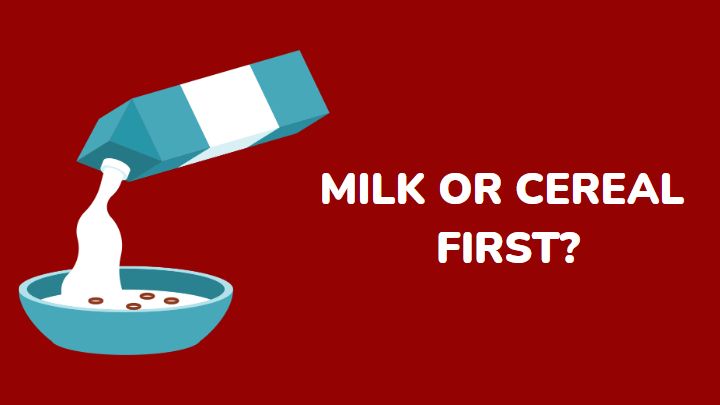As funny as it may sound, there’s a lot of controversy on how to prepare cereal with milk. Some people say the milk should go into the bowl before cereals, while others say it should be the other way around.
Some even believe it’s a ‘cardinal sin’ to put the milk first.
Those who argue for the milk to go first say that letting cereal hover above the milk makes it more crunchy and less soggy. I believe that milk or cereal can go first, whichever way you like it.
Why put cereal first?
If you strictly follow the instructions on your cereal box, you’ll find yourself putting the cereal before milk. It invariably means that cereal manufacturers believe cereals are more enjoyable when you pour milk over them.
Those who argue in favor of cereal first also believe that pouring milk over cereal allows it to distribute and moisten the cereals evenly.
Let’s compare this with salad and dressing. It isn’t ideal to pour the dressing before the salad. The vegetables have to go first before the liquid for even coating.
Moreso, milk might splash while pouring the cereals, and most of them will float above the milk until you push them in. Pushing cereals into milk makes it soggy and less appealing to eat.
Why put milk first?
The unconventional style of eating cereals is to pour your milk into the bowl first. People in this school of thought prefer crunchy cereals. So, they prefer to pour the milk first and the cereals after.
These people would rather not mix the cereals with milk. They love to eat their cereal while it’s floating in the milk.
This style works well with Obol cereals. Obol is more compact than cornflakes or oatmeal. So you can pour the milk first and the cereals after. You can push Obol into milk without worrying about it getting soggy.
This style is also perfect for cereal and curdled milk. Pouring the milk first can save you from wasting your cereals.
Additionally, the method works for people with lactose intolerance. Pouring the milk before the cereals allows them to eat enough cereal before it absorbs the milk.
How much milk should you have with cereal?
125ml of milk is just perfect for 30 grams of cereal. How much milk you have with cereals depends on how much you like milk, the fat content of the milk, your daily calorie allowance, and if you have dairy allergies.
People who don’t care much about milk and those with dairy allergies will not take as much milk as those who love milk and do not have any dairy allergies.
In addition, milk greatly contributes to your total calorie intake. Therefore, you should drink milk according to your daily calorie allowance.
What can replace milk in cereal?
If you’re lactose intolerant or vegan, you should consider other plant-based or dairy-free alternatives.
These alternatives also make your cereal taste great. Some excellent alternatives include:
- Oat milk
- Almond milk
- Soy milk
- Rice drink
- Quinoa beverages
- Flax drink
- Macadamia drink
- Cashew drink
FAQs
Can you eat cereals without milk?
Yes. You can eat cereal on its own as a sweet crunchy snack. It will be dry, but you can wash it down with water.
Are Cheerios and milk a healthy breakfast?
Yes. Cheerios with milk have lower calories when compared with some cereals, so it’s healthier and more nutritious than other cereals with milk.
Is cereal better with hot or cold milk?
Cereal is better with warm milk because it harnesses its flavor and scent. However, if you prefer crunchy cereal, take your cereals with cold milk.
Final thought
There are one thousand and one recipes when it comes to food. Everyone has the freedom to choose how they cook their food.
How you eat your cereals is all up to you. Milk or cereals first; what matters most is that you are eating a healthy combo.
If you have always had it in just one way, why not have the best of both worlds by alternating what goes first every morning?
I hope this article helped you. Thanks for reading.
Read more informational articles like this on Millenora.

